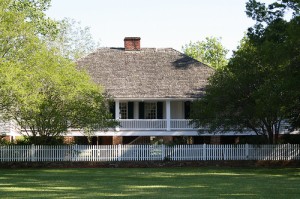
The front garden, just inside the fence in front of Kent House is the Parterre Garden. A Parterre Garden is a formal garden on a level surface edged in stone or tightly clipped hedging. It was designed by a 16th century French nursery designer Claude Mollet, who wanted a garden to fulfill a different purpose. Rather than simply being viewed by someone passing by, he intended his garden to be viewed from high windows or balconies. The Parterre Garden at Kent House, while not really formal, represents the beauty experienced by residents of the Plantation. It currently is a work in progress that has been brought back to some of the original plantings of the early days of the Plantation. Since we cannot be one hundred percent sure of what was in this particular garden, research has shown what a typical garden of this era, and in this area, would have grown. It is beautiful and colorful at all times of the year and brings to mind residents of long ago seated on the front gallery looking down on their Parterre Garden in the early 1800’s.
Situated next to the open-hearth kitchen is an Herb Garden. This garden is actually divided into three sections with three different types of herbs—culinary, medicinal and scented. Some of the herbs planted in this garden are fennel, sage, bay, rosemary, chives and various mints. These three beds are beautiful as well as functional and are part of the education programs at Kent House.
The Kitchen Garden next to the barn is modeled after vegetable gardens of the Kent House era. There are always seasonal vegetables, which along with the culinary herbs, are used by volunteer cooks for open-hearth cooking demonstrations. The vegetables are planted in raised beds within a fenced area. Along the inside of the fence are annuals and perennials such as Jobs Tears, Sweet Peas, Milk Weed and more. There are also large plants such as artichokes which would take up too much room if planted within the interior garden space. All plantings are historically accurate as to what plants are in the garden as well as to placement of these plants. This is another important educational tool which gives an additional insight as to the lives lived in this particular period in history.
There is a new and important addition to the gardens, a historically accurate iris bed in front of the Gift Shop. A project of the Alexandria Garden Club, these irises are labeled and date back to the early days of the plantation. In various writings and journals of the plantation, references are made to some of the plants that were actually on this plantation and one of the references mentions white irises. This bed will also become an important part of the gardens of Kent House.
And, then, there are the roses. Kent House is well known for its beautiful heirloom roses which are located all over the site. There are approximately 75 Old Garden Roses on site, the vast majority of which have been identified and labeled, a project of the Central Louisiana Rose Society. Examples of some of these roses are Old Blush (1752), Fortunes Double Yellow (1845), Chestnut (1814), Mutabulis (1800’s), and Luis Phillippe (1834).
Also on the site, but not in a particular garden are: azaleas, camellias, lantana, hibiscus, sweet olive, fruit trees, sassafras trees, crepe myrtles, altheas, magnolias and flowering perennials. Fairly new to Kent House, but a very old species, are two chinaberry trees (introduced in the United States in the mid 1800’s), and our newest addition, a catalpa tree (planted in the Eastern United States in the 1700’s). There is always something green and/or blooming at Kent House.
All of these gardens are maintained by wonderful Kent Plantation House volunteers. There are representatives from groups such as Master Gardeners, Alexandria Garden Club, Central Louisiana Herb Society, Central Louisiana Rose Society, students from the Youth Challenge Group, Camp Kent House summer campers, Eagle Scouts and many, many others who just love to garden and who have a special place in their hearts for the Kent House gardens. The third Saturday of each month, these gardeners gather at Kent House around 8:30am for a day of hard work, fun and fellowship. For anyone who loves gardening, we have a spot for you and we would love to have you! Please give us a call at (318) 487-5660.








